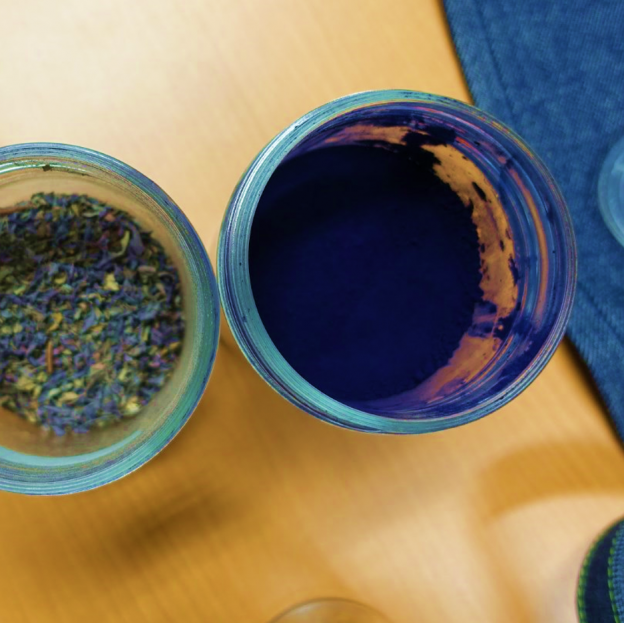In times, you discovered that some of the most popular Japanese jeans are labeled as ‚NATURAL INDIGO‚ or ‚PURE INDIGO‚ jeans. What exactly do these labels mean? What are the differences between these 2 different dyes and how do they affect the quality of each denim? After all, can you really be a denimhead without knowing about the most critical factor that makes up jeans?
To satisfy your curiosity, let’s start with the essential INDIGO dye knowledge. Denimio’s blog is proud to present 5 informative/interesting facts of indigo dye. Be with us, because after this chock-full-of-info piece, you’ll have a better understanding of various indigo dye and be able to distinguish the differences between natural and pure indigo denim. Let’s start!
Fact No.1 “Indigo plants are not blue”
To create a natural indigo color for dyeing Japanese denim, a plant called Indigofera is used. Indigofera plant is a low shrub with the height that reaches up to 2 meters. It has elongated shape leaves and lovely pink flowers.

 Example of a finished dye in the form of powder next to dried leaves of indigo.
Example of a finished dye in the form of powder next to dried leaves of indigo.
The indigo dye itself is obtained from the dried leaves of the Indigofera plant in a long process. Initially, the Indigofera leaves are thoroughly dried before the extract is prepared and infused in special vats. Following that, the extract is going through a dye maturing process, which requires detailed care and periodic stirring. After the extract is perfectly infused, the water from the tank is drained and dried. Finally, the extract is taking the form of a dark blue powder. Interesting?
Now, sometimes you found that some Japanese jeans are labeled as ‘NATURALLY INDIGO’ or ‘NATURALLY DYED’ jeans. As an example, check out one of the most best-selling jeans, Pure Blue Japan ai-001 Natural Shoai Dyed Regular Straight. So what exactly does the label means? Right, these jeans were dyed with the natural indigo dye that has been processed in a time-consuming process as described above.
 Pure Blue Japan AI-001 Natural Shoai Dyed Jeans
Pure Blue Japan AI-001 Natural Shoai Dyed Jeans
Fact no.2 “Pure indigo was born to support industry”
Different from natural indigo dye, pure indigo dye was first synthesized by the German chemist Adolf von Baeyer in the year 1865. Then, later in the year 1897, BASF, a German chemical company (currently known as the largest chemical producer in the world) began to produce this type of dye on an industrial scale. This remarks the begin of the era of the so-called „pure indigo“ denim.
The threads dyed with pure indigo dye has a beautiful and uniform shade. Around the same time, synthetic indigo was used to dye yarn for various vintage jeans.


Pure Indigo dye is often assumed to be threads that are dyed with the classical chemical formula of pure indigo. Most people believe that pure indigo denim does not have additional shades of the green or red cast texture. In fact, there are several indigo shades that have been introduced among Japanese denim.
To know more about the non-standard shades of pure indigo denim, you can get more information about it by reading our previous article ‘Know your colors – red, green and blue!” here. You might want to check your jeans to make sure if they’re Pure indigo or Natural indigo denim. Let us know in the comment box below!
Fact no.3 “Hand-dyed indigo is ageless”
The best feature of the manual dyeing of indigo yarns is the almost complete absence of fading as the thread is thoroughly dyed. Such jeans only slightly brighten at the folds. It’s a very rare and expensive method of dying, which is used only for natural indigo dyes. The threads are repeatedly dyed, dried and washed by hand. The method requires extremely complicated and painstaking manual work.
The threads will gradually become a darker color. In addition, the indigo color made with this method of dying has different shades (lighter and darker threads interweave, giving the finished piece a natural and intricate look).

Here’s a sample of hand-dyed indigo jeans, Pure Blue Japan AI-002 Natural Shoai Dyed Slim Straight.
The texture and color of expensive denim are shown below, with different indigo shades. Due to this, a unique “artistic pattern” is organically created.
Fact no.4 “Contrast fading is possible because of the mechanical staining method used”
There are several ways to mechanically dye yarns with indigo dye. The most famous is the rope dyeing. This method is used both for dyeing synthetic indigo (including pure indigo) and natural plant indigo. A special machine dips the threads in the dye and then the threads are dried. This process takes place continuously, as shown in the photo below.


When it comes to contrasting denim, we shall mention the top denim producer, Oni Denim. The greatest release of their jeans with natural indigo can be shown in the Oni Kiraku series (read our previous blog story to know more about Kiraku denim here)
 4 Oni Kiraku with different sunlight and cutting
4 Oni Kiraku with different sunlight and cutting
This is a very light, comfortable, and beautiful denim with the pure and deep color of natural plant indigo. When shrinking jeans, if you suddenly see that the water is turning into a thick „wine“ color, then this is a sign that the jeans were colored with natural indigo dye.
Fact no.5 “Natural indigo jeans can be affordable”
Natural indigo jeans are difficult to produce as they require a lot of time and professional skills, so the production process keeps the denim at a high price. But, believe it or not? Natural indigo jeans on a budget can be real.
 Burgus plus 850 $165 – On the right is the model with arches on the pockets
Burgus plus 850 $165 – On the right is the model with arches on the pockets
Above are low-rise jeans from Burgus Plus in a very comfortable and modern cut with a slightly narrowed leg, and it has a density of 16OZ. Here we showcase their very beautiful texture in the form of „grains“, which possess fast-fading qualities and the amazing color of natural indigo.
 Over time, when the jeans are worn, it will show unique and beautiful fading.
Over time, when the jeans are worn, it will show unique and beautiful fading.
Another model of the natural indigo jeans is ON850ST 15OZ Burgus Plus x Oni Denim. Dye from natural plant indigo denim was used but added with elastic additives of 2%. Externally and according to its properties, this denim is exactly the same as the classic 100% cotton denim. It is slightly more elastic and gives more freedom of movement. These jeans would be an excellent option for long, sedentary work.

Bottom Line
Denim fabrication is complicated and that’s what makes every Japanese jeans special. We believe that is more fun for denim lovers to know how things work before they buy a pair on the shelf. Natural and synthetic indigo both do great jobs on different styles of dying. Natural indigo is the most authentic dye while Pure indigo gives a better fading potential. If you haven’t tried on either type of natural/pure indigo denim before, there will be a lot of different and exciting experiences waiting for you. Be our guest and share with us via ping on chat 😉
Think Blue. Think Denimio.










